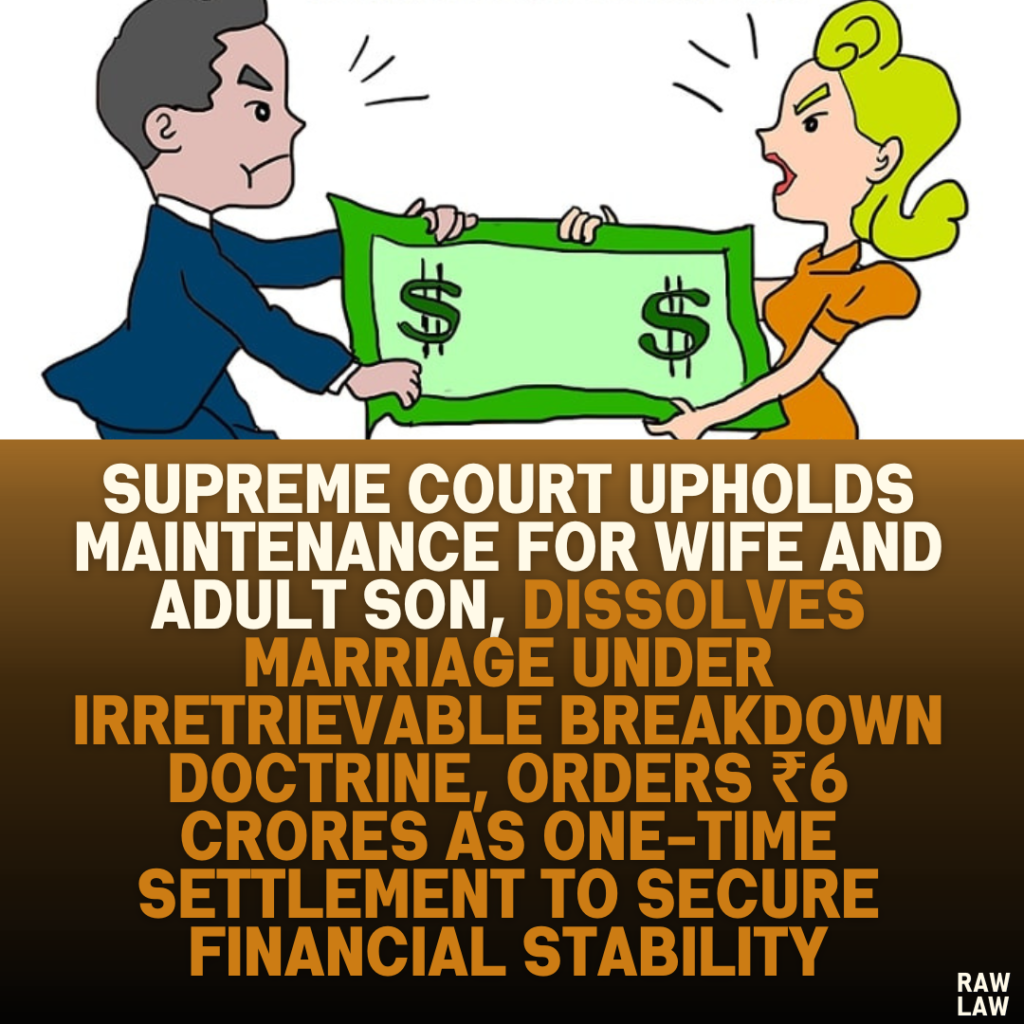1. Court’s Decision
The Supreme Court:
- Dissolved the Marriage: Exercising powers under Article 142 of the Constitution, the Court dissolved the marriage on grounds of irretrievable breakdown.
- Enhanced Maintenance: Increased the maintenance for the respondent (wife) and the son.
- Directed One-Time Settlement: Ordered the appellant (husband) to pay ₹5 crores to the wife as permanent alimony and ₹1 crore for the son’s financial security and education.
2. Facts
- Marriage and Separation: The parties were married in 1998 but separated in 2004 after five years of cohabitation. The respondent has custody of their son since separation.
- Initial Legal Actions: The appellant filed for divorce in 2004, citing cruelty. The respondent filed for pendente lite maintenance under Section 24 of the Hindu Marriage Act, 1955 (HMA).
- Maintenance Orders:
- The Family Court initially granted ₹18,000 per month as maintenance, which was enhanced to ₹1,15,000.
- The High Court increased this amount further to ₹1,45,000 per month.
- Appellant’s Contentions: The appellant argued that the Family Court lacked jurisdiction after the withdrawal of the divorce petition and objected to the maintenance granted for an adult son.
- Respondent’s Position: She argued for higher maintenance due to increased financial needs and the appellant’s significant financial capacity.
3. Issues
- Jurisdiction of the Family Court: Does the Family Court retain jurisdiction to decide pending maintenance applications after the withdrawal of the divorce petition?
- Maintenance for an Adult Son: Is granting maintenance to an adult male child valid under the HMA?
- Quantum of Permanent Alimony: What is the appropriate amount of alimony and financial support considering the facts of the case?
4. Petitioner’s Arguments
- Functus Officio Doctrine: Claimed that the Family Court became functus officio (lost jurisdiction) after the withdrawal of the divorce petition.
- Maintenance for the Son: Contended that maintenance could not be granted for an adult male child under Section 26 of the HMA.
- Financial Hardship: Asserted that the maintenance orders were excessive and punitive, despite fulfilling prior maintenance obligations.
5. Respondent’s Arguments
- Increased Financial Needs: Highlighted that the son’s education and her own living expenses had increased significantly over the years.
- Appellant’s Financial Transparency: Accused the appellant of hiding his true financial status and delaying the proceedings.
- Rightful Claim: Emphasized the appellant’s moral and legal obligation to provide adequate financial support for her and the son.
6. Analysis of the Law
- Section 24 of the HMA:
- The Court clarified that pendente lite maintenance aims to ensure financial security for a dependent spouse during matrimonial disputes.
- Maintenance applications under Section 24 are independent and continue even if the main petition is withdrawn.
- Section 26 of the HMA:
- The provision allows orders regarding child maintenance irrespective of the status of the primary matrimonial proceedings.
- Welfare of the child is paramount and cannot be restricted based on procedural formalities.
- Article 142 of the Constitution:
- The Court reiterated its discretionary power to dissolve marriages under irretrievable breakdown doctrine when reconciliation is impossible and litigation has prolonged.
7. Precedent Analysis
- Shilpa Sailesh v. Varun Sreenivasan: Recognized irretrievable breakdown as a valid ground for divorce and emphasized the need for factual analysis before granting divorce under Article 142.
- Rajnesh v. Neha: Established guidelines for determining maintenance, including factors like financial transparency, the dependent spouse’s needs, and the lifestyle during the marriage.
- Vinny Paramvir Parmar v. Paramvir Parmar: Stressed that maintenance should ensure the dependent spouse’s dignity without penalizing the paying spouse.
8. Court’s Reasoning
- Jurisdiction of Family Court:
- Maintenance proceedings under Sections 24 and 26 of the HMA are not strictly ancillary to divorce proceedings.
- The withdrawal of the divorce petition does not negate the obligation to provide financial support.
- Financial Transparency:
- The appellant’s substantial income, assets, and investments proved his ability to pay enhanced maintenance.
- Evidence revealed attempts to conceal financial details, justifying judicial intervention.
- Irretrievable Breakdown:
- The parties were separated for two decades, and reconciliation attempts had failed.
- Mutual agreement to divorce further supported the Court’s conclusion of irretrievable breakdown.
- Child Welfare:
- The son’s financial dependence justified continued maintenance until he achieves financial independence.
9. Conclusion
- Dissolution of Marriage: The Court dissolved the marriage, exercising its powers under Article 142.
- Permanent Alimony: Directed the appellant to pay ₹5 crores to the respondent.
- Child Maintenance: Ordered ₹1 crore for the son’s education and financial security.
- Timelines: The amounts are to be paid within four months.
10. Implications
- Strengthened Doctrine of Irretrievable Breakdown:
- Confirms the Court’s willingness to dissolve marriages that have irretrievably broken down, even if not explicitly recognized under statutory law.
- Independent Maintenance Jurisdiction:
- Affirms that maintenance claims are independent and do not cease with the withdrawal of the main petition.
- Emphasis on Financial Transparency:
- Highlights the obligation of spouses to disclose true financial status to ensure equitable maintenance orders.




Pingback: Supreme Court Holds Temporary Appointments Do Not Confer Right to Reinstatement, Awards ₹5 Lakh Compensation, Rejecting "Negative Equality" Argument Under Article 14 - Raw Law